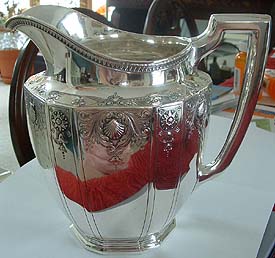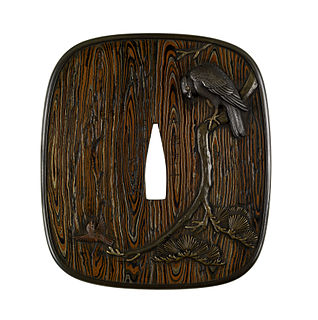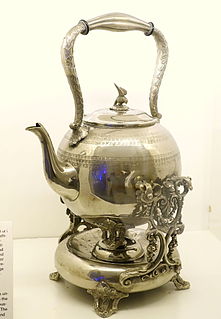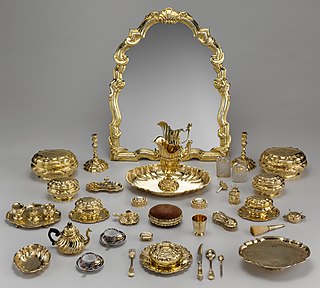Related Research Articles

Electroplating is a general name for processes that create a metal coating on a solid substrate through the reduction of cations of that metal by means of a direct electric current. The part to be coated acts as the cathode of an electrolytic cell; the electrolyte is a solution of a salt of the metal to be coated; and the anode is usually either a block of that metal, or of some inert conductive material. The current is provided by an external power supply.
Pewter is a malleable metal alloy composed of 85–99% tin, mixed with approximately 5–10% antimony, 2% copper, bismuth, and sometimes silver. Copper and antimony act as hardeners but may be replaced with lead in lower grades of pewter, imparting a bluish tint. Pewter has a low melting point, around 170–230 °C (338–446 °F), depending on the exact mixture of metals. The word pewter is probably a variation of the word spelter, a term for zinc alloys.
Cupronickel or copper-nickel (CuNi) is an alloy of copper that contains nickel and strengthening elements, such as iron and manganese. The copper content typically varies from 60 to 90 percent.

Sterling silver is an alloy of silver containing 92.5% by weight of silver and 7.5% by weight of other metals, usually copper. The sterling silver standard has a minimum millesimal fineness of 925.

Nickel silver, Maillechort, German silver, Argentan, new silver, nickel brass, albata, alpacca, is a copper alloy with nickel and often zinc. The usual formulation is 60% copper, 20% nickel and 20% zinc. Nickel silver is named due to its silvery appearance, but it contains no elemental silver unless plated. The name "German silver" refers to its development by 19th-century German metalworkers from the Chinese alloy known as paktong or baitong (白銅). All modern, commercially important nickel silvers contain significant amounts of zinc, and are sometimes considered a subset of brass.

An ingot is a piece of relatively pure material, usually metal, that is cast into a shape suitable for further processing. In steelmaking, it is the first step among semi-finished casting products. Ingots usually require a second procedure of shaping, such as cold/hot working, cutting, or milling to produce a useful final product. Non-metallic and semiconductor materials prepared in bulk form may also be referred to as ingots, particularly when cast by mold based methods. Precious metal ingots can be used as currency, or as a currency reserve, as with gold bars.

Cutlery includes any hand implement used in preparing, serving, and especially eating food in Western culture. A person who makes or sells cutlery is called a cutler. The city of Sheffield in England has been famous for the production of cutlery since the 17th century and a train – the Master Cutler – running from Sheffield to London was named after the industry. Bringing affordable cutlery to the masses, stainless steel was developed in Sheffield in the early 20th century.

Mokume-gane (木目金) is a Japanese metalworking procedure which produces a mixed-metal laminate with distinctive layered patterns, as well as that laminate itself. Mokume-gane translates closely to "wood grain metal" or "wood eye metal" and describes the way metal takes on the appearance of natural wood grain. Mokume gane fuses several layers of differently coloured precious metals together to form a sandwich of alloys called a "billet." The billet is then manipulated in such a way that a pattern resembling wood grain emerges over its surface. Numerous ways of working the mokume gane create diverse pattens. Once the metal has been rolled into a sheet or bar, several techniques are used to produce a range of effects.
Sheffield plate is a layered combination of silver and copper that was used for many years to produce a wide range of household articles. Almost every article made in sterling silver was also crafted by Sheffield makers, who used this manufacturing process to produce nearly identical wares at far less cost. The process and material are sometimes compared to the Japanese mokume-gane.

Tableware are the dishes or dishware used for setting a table, serving food and dining. It includes cutlery, glassware, serving dishes and other items for practical as well as decorative purposes. The quality, nature, variety and number of objects varies according to culture, religion, number of diners, cuisine and occasion. For example, Middle Eastern, Indian or Polynesian food culture and cuisine sometimes limits tableware to serving dishes, using bread or leaves as individual plates. Cups are not dishes. Special occasions are usually reflected in higher quality tableware.
Plating is a surface covering in which a metal is deposited on a conductive surface. Plating has been done for hundreds of years; it is also critical for modern technology. Plating is used to decorate objects, for corrosion inhibition, to improve solderability, to harden, to improve wearability, to reduce friction, to improve paint adhesion, to alter conductivity, to improve IR reflectivity, for radiation shielding, and for other purposes. Jewelry typically uses plating to give a silver or gold finish.

Zari is an even thread traditionally made of fine gold or silver used in traditional Indian, Bangladeshi and Pakistani garments, especially as brocade in saris etc. This thread is woven into fabrics, primarily of silk, to make intricate patterns and elaborate designs of embroidery called zardozi. Zari was popularised during the Moghul era, the port of Surat was linked to the Meccan pilgrimage route which served as a major factor for re-introducing this ancient craft in India. During the Vedic ages, the gold embroidery was associated with the grandeur and regal attire of gods, kings, and literary figures (gurus){as shown in the movies}. Today in most fabrics, zari is not made of real gold and silver, but has cotton or polyester yarn at its core, wrapped by golden/ silver metallic yarn.

Britannia metal is a specific type of pewter alloy, favoured for its silvery appearance and smooth surface. The composition by weight is typically about 92% tin, 6% antimony, and 2% copper.

Household silver or silverware includes tableware, cutlery, and other household items made of sterling silver, silver gilt, Britannia silver, or Sheffield plate silver. Silver is sometimes bought in sets or combined to form sets, such as a set of silver candlesticks or a silver tea set.

Japanese Industrial Standards (JIS) are the standards used for industrial activities in Japan, coordinated by the Japanese Industrial Standards Committee (JISC) and published by the Japanese Standards Association (JSA). The JISC is composed of many nationwide committees and plays a vital role in standardizing activities across Japan.
In metallurgy, refining consists of purifying an impure metal. It is to be distinguished from other processes such as smelting and calcining in that those two involve a chemical change to the raw material, whereas in refining, the final material is usually identical chemically to the original one, only it is purer. The processes used are of many types, including pyrometallurgical and hydrometallurgical techniques.

Russian tableware plant Kolchug-Mizar is the largest manufacturer of tableware, plate and cutlery in Russia. It was founded in 1871. The plant is situated not far from Moscow. Kolchugino plant is well-known most because of popular kolchugino tea glass-holders or podstakanniks.
Metals and metal working had been known to the people of modern Italy since the Bronze Age. By 53 BC, Rome had expanded to control an immense expanse of the Mediterranean. This included Italy and its islands, Spain, Macedonia, Africa, Asia Minor, Syria and Greece; by the end of the Emperor Trajan's reign, the Roman Empire had grown further to encompass parts of Britain, Egypt, all of modern Germany west of the Rhine, Dacia, Noricum, Judea, Armenia, Illyria, and Thrace. As the empire grew, so did its need for metals.

Galvanic corrosion is an electrochemical process in which one metal corrodes preferentially when it is in electrical contact with another, in the presence of an electrolyte. A similar galvanic reaction is exploited in primary cells to generate a useful electrical voltage to power portable devices.
References
- ↑ . Encyclopædia Britannica (11th ed.). 1911.
- ↑ Hirst, R.M.; Veitch, Henry Newton (August 1920). "Sheffield Plate: A Brief Sketch of the Silver-Plated Establishments". The Burlington Magazine for Connoisseurs. The Burlington Magazine Publications, Ltd. 37 (209): 89–95.
- ↑ "Sheffield's Cutlery History". Littlemesters of Sheffield. Archived from the original on 2006-10-25. Retrieved 2007-03-25.
- ↑ "Electroplating". R&S Electroplating. Archived from the original on 2007-01-24. Retrieved 2007-03-25.